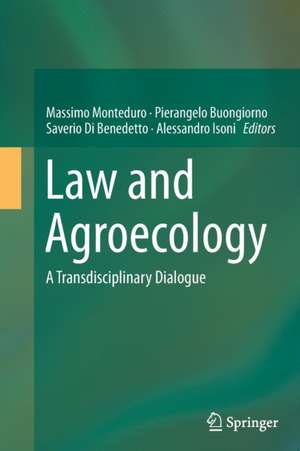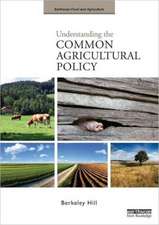Law and Agroecology: A Transdisciplinary Dialogue
Editat de Massimo Monteduro, Pierangelo Buongiorno, Saverio Di Benedetto, Alessandro Isonien Limba Engleză Paperback – 29 oct 2016
There is a need to adopt a transdisciplinary approach to multifunctional agriculture in order to integrate the agroecological paradigm in legal regulation. This does not require a super-law that hierarchically purports to incorporate and supplant the existing legal fields; rather, it calls for the creation of a trans-law that progressively works to coordinate interlegalities between different legal fields, respecting their autonomy but emphasizing their common historical roots in rus in the process.
Rus, the rural phenomenon as a whole, reflects the plurality and interdependence of different complex systems based jointly on the land as a central point of reference. “Rural” is more than “agricultural”: if agriculture is understood traditionally as an activity aimed at exploiting the land for the production of material goods for use, consumption and private exchange, rurality marks the reintegration of agriculture into a broader sphere, one that is not only economic, but also social and cultural; not only material, but also ideal, relational, historical, and symbolic; and not only private, but also public.
In approaching rus, the natural and social sciences first became specialized, multiplied, and compartmentalized in a plurality of first-order disciplines; later, they began a process of integration into Agroecology as a second-order, multi-perspective and shared research platform. Today, Agroecology is a transdiscipline that integrates other fields of knowledge into the concept of agroecosystems viewed as socio-ecological systems.
However, the law seems to still be stuck in the first stage. Following a reductionist approach, law has deconstructed and shattered the universe of rus into countless, disjointed legal elementary particles, multiplying the planes of analysis and, in particular, keeping Agricultural Law and EnvironmentalLaw two separate fields.
| Toate formatele și edițiile | Preț | Express |
|---|---|---|
| Paperback (1) | 1118.30 lei 6-8 săpt. | |
| Springer Berlin, Heidelberg – 29 oct 2016 | 1118.30 lei 6-8 săpt. | |
| Hardback (1) | 1124.47 lei 6-8 săpt. | |
| Springer Berlin, Heidelberg – 19 mai 2015 | 1124.47 lei 6-8 săpt. |
Preț: 1118.30 lei
Preț vechi: 1363.78 lei
-18% Nou
Puncte Express: 1677
Preț estimativ în valută:
214.04€ • 220.58$ • 180.70£
214.04€ • 220.58$ • 180.70£
Carte tipărită la comandă
Livrare economică 03-17 martie
Preluare comenzi: 021 569.72.76
Specificații
ISBN-13: 9783662526354
ISBN-10: 3662526352
Pagini: 513
Ilustrații: XIX, 494 p. 50 illus., 14 illus. in color.
Dimensiuni: 155 x 235 x 26 mm
Greutate: 0.72 kg
Ediția:Softcover reprint of the original 1st ed. 2015
Editura: Springer Berlin, Heidelberg
Colecția Springer
Locul publicării:Berlin, Heidelberg, Germany
ISBN-10: 3662526352
Pagini: 513
Ilustrații: XIX, 494 p. 50 illus., 14 illus. in color.
Dimensiuni: 155 x 235 x 26 mm
Greutate: 0.72 kg
Ediția:Softcover reprint of the original 1st ed. 2015
Editura: Springer Berlin, Heidelberg
Colecția Springer
Locul publicării:Berlin, Heidelberg, Germany
Cuprins
Part I: Law and Agroecology: Crossing the Boundaries Between Natural, Social and Legal Sciences: 1. History and Development of Agroecology and Theory of Agroecosystems by Fabio Caporali.- 2. Regulation of Agroecosystems: A Social Systems Analysis of Agroecology and Law by Egon B. Noe and Hugo F. Alrøe.- 3. Addressing Law and Agroecosystems, Sovereignty and Sustainability from a Legal Pluralistic Perspective by Otto Hospes.- 4. From Agroecology and Law to Agroecological Law? Exploring Integration Between Scientia Ruris and Scientia Iuris by Massimo Monteduro.- 5. Agriculture, Environment and Law Between Ancient Experiences and Present Knowledge: Some Remarks by Pierangelo Buongiorno.- 6. Agriculture and the Environment in International Law: Towards a New Legal Paradigm? by Saverio Di Benedetto.- 7. Ecosystem Services: European Agricultural Law and Rural Development by Brian Jack.- 8. The Rural Development Programme (RDP) as a Strategic Tool for Linking Legal and Agroecological Perspectives by Giuseppina Buia and Mariacristina Antonucci.- Part II: Multidimensional Relations Between Land, Agriculture and the Environment: 9. The Common Agricultural Policy (CAP): Achievements and Future Prospects by Alessandro Isoni.- 10. Environment, Landscape, Agriculture and Food in the Framework of State and Regional Legislative Powers as per Art. 117 of the Italian Constitution by Michele Troisi.- 11. The Relationship between Agricultural Law and Environmental Law in Italy by Eloisa Cristiani.- 12. The Relationship between Agricultural Law and Environmental Law in France by Carole Hermon.- 13. The Relationship between Agricultural Law and Environmental Law in Hungary by János Ede Szilágyi.- 14. The Relationship between Agricultural Law and Environmental Law in The United States of America by Elizabeth Dooley.- 15. Crossing the Boundaries between Agricultural Law andLandscape Law: The Rural Landscape by Marco Brocca.- 16. Agri-Food Market And Eco-Oriented Consumer Law: Towards a New Model by Sara Tommasi.- 17. Emerging Land-Use Cross-Scale Patterns and the Pirsig’s Monkey Trap by Giovanni Zurlini, Teodoro Semeraro, Roberta Aretano, Maria Rita Pasimeni, Antonella De Marco, Idelberto Castorini, Nicola Zaccarelli, and Irene Petrosillo.- 18. Reshaping Agriculture toward a Transition to a Post-Fossil Bioeconomy by Massimo Monteleone.- 19. Biofuel Regulation in the EU: A Failure in the Path towards Environmental Sustainability and Food Security? by Mariagrazia Alabrese.- Part III: Rural Sustainable Development and Rural Civilization: 20. Agroecology and Politics: On the Importance of Public Policies in Europe by Manuel González de Molina Navarro.- 21. Sustainability Science: A Possible Strategy to Enhance Resilience to Climate and Rural Ecosystem Changes by Stefano Grego and Vincenzo Naso.- 22. Agriculture, Climate Change and Law by Scilla Vernile.- 23. Knowledge-Based Greening as a New Bioeconomy Strategy for Development: Agroecological Utopia or Revolution? by Emmanuel G. Koukios.- 24. Agrobiodiversity, Intellectual Property Rights and Right to Food: The Case of Andean Countries by Maurizia Pierri.- 25. The Constitutional Dimension of Traditional Rural Skills: Protection and Promotion by Antonello Denuzzo.- 26. On the Humanity of Land by Achille de Nitto.
Textul de pe ultima copertă
This book represents a first attempt to investigate the relations between Law and Agroecology.
There is a need to adopt a transdisciplinary approach to multifunctional agriculture in order to integrate the agroecological paradigm in legal regulation. This does not require a super-law that hierarchically purports to incorporate and supplant the existing legal fields; rather, it calls for the creation of a trans-law that progressively works to coordinate interlegalities between different legal fields, respecting their autonomy but emphasizing their common historical roots in rus in the process.
Rus, the rural phenomenon as a whole, reflects the plurality and interdependence of different complex systems based jointly on the land as a central point of reference. “Rural” is more than “agricultural”: if agriculture is understood traditionally as an activity aimed at exploiting the land for the production of material goods for use, consumption and private exchange, rurality marks the reintegration of agriculture into a broader sphere, one that is not only economic, but also social and cultural; not only material, but also ideal, relational, historical, and symbolic; and not only private, but also public.
In approaching rus, the natural and social sciences first became specialized, multiplied, and compartmentalized in a plurality of first-order disciplines; later, they began a process of integration into Agroecology as a second-order, multi-perspective and shared research platform. Today, Agroecology is a transdiscipline that integrates other fields of knowledge into the concept of agroecosystems viewed as socio-ecologicalsystems.
However, the law seems to still be stuck in the first stage. Following a reductionist approach, law has deconstructed and shattered the universe of rus into countless, disjointed legal elementary particles, multiplying the planes of analysis and, in particular, keeping Agricultural Law and Environmental Law two separate fields.
There is a need to adopt a transdisciplinary approach to multifunctional agriculture in order to integrate the agroecological paradigm in legal regulation. This does not require a super-law that hierarchically purports to incorporate and supplant the existing legal fields; rather, it calls for the creation of a trans-law that progressively works to coordinate interlegalities between different legal fields, respecting their autonomy but emphasizing their common historical roots in rus in the process.
Rus, the rural phenomenon as a whole, reflects the plurality and interdependence of different complex systems based jointly on the land as a central point of reference. “Rural” is more than “agricultural”: if agriculture is understood traditionally as an activity aimed at exploiting the land for the production of material goods for use, consumption and private exchange, rurality marks the reintegration of agriculture into a broader sphere, one that is not only economic, but also social and cultural; not only material, but also ideal, relational, historical, and symbolic; and not only private, but also public.
In approaching rus, the natural and social sciences first became specialized, multiplied, and compartmentalized in a plurality of first-order disciplines; later, they began a process of integration into Agroecology as a second-order, multi-perspective and shared research platform. Today, Agroecology is a transdiscipline that integrates other fields of knowledge into the concept of agroecosystems viewed as socio-ecologicalsystems.
However, the law seems to still be stuck in the first stage. Following a reductionist approach, law has deconstructed and shattered the universe of rus into countless, disjointed legal elementary particles, multiplying the planes of analysis and, in particular, keeping Agricultural Law and Environmental Law two separate fields.
Caracteristici
Adopts a transdisciplinary approach to multifunctional agriculture Calls for the integration of the agro ecological paradigm in legal research and regulation Highlights the relations between Agricultural Law and Environmental Law at the national, international and EU level











